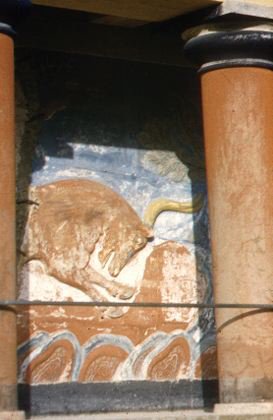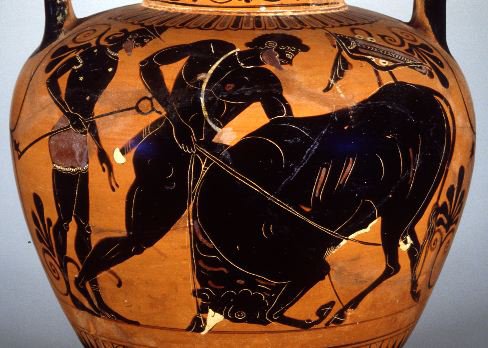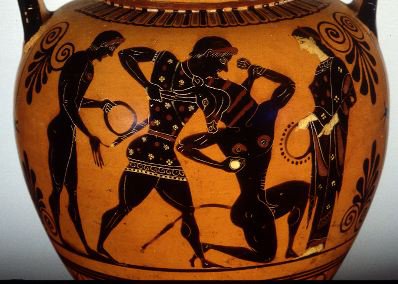The Cretan Bull
After the complicated business with the Stymphalian Birds, Hercules easily disposed of the Cretan Bull.
At that time, Minos, King of Crete, controlled many of the islands in the seas around Greece, and was such a powerful ruler that the Athenians sent him tribute every year. There are many bull stories about Crete. Zeus, in the shape of a bull, had carried Minos' mother Europa to Crete, and the Cretans were fond of the sport of bull-leaping, in which contestants grabbed the horns of a bull and were thrown over its back.

Bull fresco from the Palace of Minos in Knossos
Photograph courtesy of the Department of Archaeology, Boston University, Saul S. Weinberg Collection
Minos himself, in order to prove his claim to the throne, had promised the sea-god Poseidon that he would sacrifice whatever the god sent him from the sea. Poseidon sent a bull, but Minos thought it was too beautiful to kill, and so he sacrificed another bull. Poseidon was furious with Minos for breaking his promise. In his anger, he made the bull rampage all over Crete, and caused Minos' wife Pasiphae to fall in love with the animal. As a result, Pasiphae gave birth to the Minotaur, a monster with the head of a bull and the body of a man. Minos had to shut up this beast in the Labyrinth, a huge maze underneath the palace, and every year he fed it prisoners from Athens.
When Hercules got to Crete, he easily wrestled the bull to the ground and drove it back to King Eurystheus. Eurystheus let the bull go free. It wandered around Greece, terrorizing the people, and ended up in Marathon, a city near Athens.
 |
 |
|
Hercules ropes the Cretan Bull Mississippi 1977.3.61a and b, Attic black figure neck amphora, ca. 530-520 B.C. Photograph by Maria Daniels, courtesy of the University Museums, University of Mississippi |
Hercules drives the bull back to Mycenae Boston 99.538, Attic bilingual amphora, ca. 525-500 B.C. From Caskey & Beazley, plate LXVII. With permission of the Museum of Fine Arts, Boston. |
The Athenian hero Theseus tied up some loose ends of this story. He killed the Cretan Bull at Marathon. Later, he sailed to Crete, found his way to the center of the Labyrinth, and killed the Minotaur.

Theseus fighting the Minotaur
RISD 25.083, Attic black figure amphora, ca. 550-530 B.C.
Photograph by Maria Daniels, courtesy of the Museum of Art, RISD, Providence, RI
(das)
To read more about these topics, see Further Resources.
- Labor 1: The Nemean Lion
- Labor 2: The Lernean Hydra
- Labor 3: The Hind of Ceryneia
- Labor 4: The Erymanthean Boar
- Labor 5: The Augean Stables
- Labor 6: The Stymphalian Birds
- Labor 7: The Cretan Bull
- Labor 8: The Horses of Diomedes
- Labor 9: The Belt of Hippolyte
- Labor 10: Geryon's Cattle
- Labor 11: The Apples of the Hesperides
- Labor 12: Cerberus
This exhibit is a subset of materials from the Perseus Project digital library and is copyrighted. Please send us your comments.